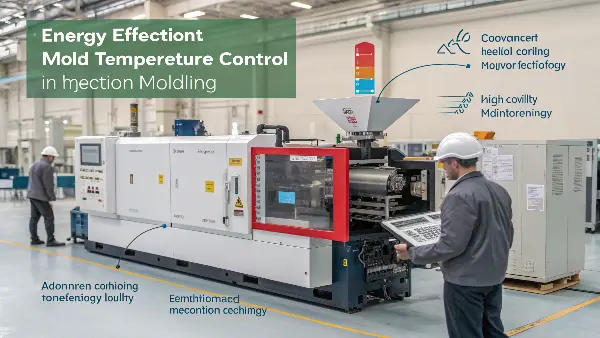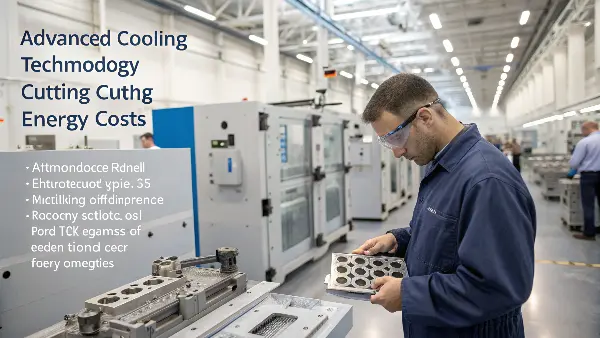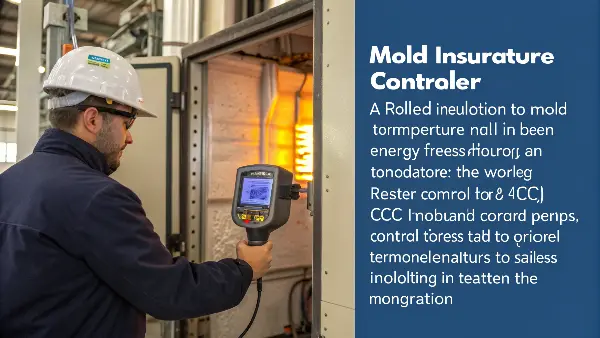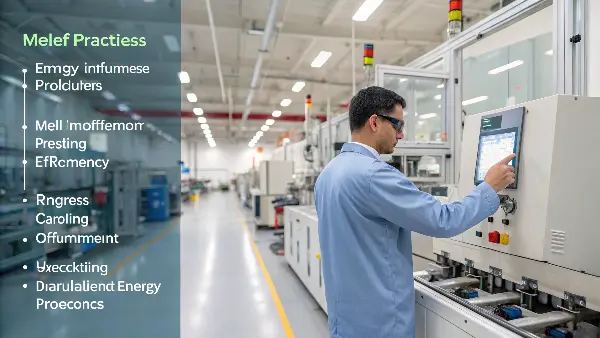High energy bills from your injection molding process are likely eating into your profits. You know that mold temperature control is a major energy consumer, but trying to optimize it can feel complex and risky. This constant pressure to cut costs while maintaining quality is a major challenge for any project manager.
The most effective strategy for energy-efficient mold temperature control involves a combined approach. This means integrating advanced technologies like conformal cooling, using proper mold insulation, selecting high-efficiency heating and cooling systems, and carefully optimizing process parameters. This holistic method reduces energy consumption significantly without compromising cycle times or the final quality of the molded parts, making your operation more sustainable and profitable.

Achieving true energy efficiency in mold temperature control is not about finding a single magic bullet. It’s about understanding how different elements work together. You have to look at the mold design, the equipment you use, and the settings you run on the machine. It might seem like a lot to tackle, but breaking it down into manageable parts makes it much clearer. Let’s explore the key strategies that will have the biggest impact on your energy bills and your bottom line.
How Does Advanced Cooling Technology Cut Energy Costs?
Are you still struggling with long cycle times and part defects caused by inefficient cooling? Conventional cooling channels are often a bottleneck, forcing you to run longer cycles than necessary, which drives up energy use across the entire production cell. This inefficiency costs you both time and money.
Advanced cooling technologies, especially conformal cooling, cut energy costs primarily by slashing the cooling phase of the injection cycle. Because cooling can account for up to 80% of the total cycle time, even a small reduction means the press, pumps, and chillers run for less time per part. This leads to substantial overall energy savings, faster production, and improved part quality due to uniform temperature control.

The real magic of advanced cooling lies in its precision. Conventional cooling involves drilling straight lines through the mold block. This is simple and cheap, but it’s rarely optimal. These channels are often far from the complex surfaces of the part, leading to hot spots, uneven cooling, and warpage. To compensate, you have to extend the cooling time, which is pure wasted energy. I remember a project with a complex automotive housing. We were fighting warpage issues constantly. The cycle time was nearly 60 seconds, and the scrap rate was too high.
Conformal cooling completely changes the game. Instead of straight lines, the cooling channels follow the contours of the mold cavity and core, like a river flowing through a valley. They stay at a consistent, optimal distance from the plastic. This allows for much faster and more uniform heat extraction. When we remade that automotive mold with conformal cooling, we cut the cycle time down to 42 seconds and the scrap rate dropped to almost zero. The initial investment in the more complex mold paid for itself in less than a year through energy savings and increased output.
Here’s a breakdown of how these technologies stack up:
| Feature | Conventional Cooling | Conformal Cooling |
|---|---|---|
| Cycle Time | Longer, less efficient | 20-50% shorter |
| Energy Consumption | High (longer press & pump operation) | Lower (reduced cycle time) |
| Part Quality | Prone to warpage, sink marks | High uniformity, fewer defects |
| Initial Mold Cost | Low | Higher (requires metal 3D printing) |
| Best For | Simple, flat parts | Complex geometries, high-volume runs |
Besides conformal cooling, other technologies like high-conductivity inserts or heat pipes can be used to target specific hot spots. The key is to analyze your part and mold design to see where the biggest gains can be made. It’s about moving from a "one-size-fits-all" approach to a targeted, engineered solution.
What’s the Role of Mold Insulation in Energy Efficiency?
You set your mold temperature controller to a precise temperature, but is your mold actually holding that heat? Molds constantly lose energy to the press platens and the surrounding air. This forces your temperature control unit (TCU) to work harder, continuously pumping in energy just to maintain the setpoint.
Mold insulation plays a critical role in energy efficiency by creating a thermal barrier. This barrier dramatically reduces heat loss from the mold to the machine platens and the atmosphere. As a result, the temperature control unit consumes far less energy to maintain the desired mold temperature, leading to faster startups, better process stability, and direct reductions in electricity costs.

Think of it like insulating your house. You wouldn’t heat your home in the winter with the windows wide open. Running a mold without insulation is essentially the same thing. The most significant heat loss occurs where the mold clamps onto the press platens. These large metal surfaces act as giant heat sinks, constantly drawing energy away. A simple insulation board placed between the mold and the platen can make a massive difference.
We ran a test at our facility on a medium-sized mold running at 80°C (176°F). Without insulation, the TCU was drawing an average of 3.8 kWh. After installing standard insulation boards, the energy draw dropped to 2.5 kWh. That’s a 34% reduction in energy needed just to hold the temperature, not to mention the energy saved during the initial heat-up. It’s one of the highest-ROI improvements you can make in injection molding. The payback period is often just a few months.
Here’s where insulation provides the most value:
| Action | Benefit | Impact on Energy |
|---|---|---|
| Insulate between Mold & Platens | Prevents heat transfer to the press. | High. This is the most critical area for heat loss. |
| Insulate Non-functional Mold Surfaces | Reduces heat loss to the ambient air. | Medium. Most effective for high-temp molds. |
| Insulate Hot Runner Manifolds | Keeps heat focused where needed. | High. Prevents heat bleed and improves process control. |
The materials used for insulation are typically rigid, durable composites or ceramic-based sheets that can withstand the high clamping forces of the press. While it seems like a small detail, proper insulation is a foundational element of a sustainable molding operation. It stabilizes your process, making it easier to achieve consistent part quality, and delivers direct, measurable energy savings every single cycle.
Can Optimizing Process Parameters Really Make a Difference?
Does your team rely on "tribal knowledge" or old setup sheets to set process parameters? While these can be a starting point, they are rarely optimized for energy efficiency. Running a melt temperature that’s too high or a cooling time that’s too long directly translates into wasted electricity and higher costs per part.
Yes, optimizing process parameters can make a huge difference in energy consumption. By systematically reducing melt temperature to the lowest possible point, minimizing injection pressure, and shortening cooling time to its scientific minimum, you directly reduce the energy demand on the machine’s heaters and cooling system. This data-driven approach, known as scientific molding, improves both efficiency and part consistency.

The goal of process optimization is to find the "sweet spot" where you can make a quality part with the lowest possible energy input. This isn’t guesswork; it’s a science. The two biggest levers you can pull are melt temperature and cooling time. Many processors run their materials hotter than necessary "just to be safe," to ensure the mold fills completely. However, every extra degree of heat you add to the plastic must be removed by the cooling system. This is a double energy penalty: first, you use more energy to heat the material, and second, you use more energy to cool it back down.
A few years ago, we were consulting for a client in the consumer goods space. They were molding millions of polypropylene caps. Their process sheet called for a melt temperature of 230°C and a cooling time of 8 seconds. Through a systematic process of experimentation, we found that a perfect part could be made at 215°C with a cooling time of just 6 seconds. This seemingly small change had a massive impact.
Here’s a simple look at the cause and effect:
| Parameter Adjustment | Primary Effect | Impact on Energy Use |
|---|---|---|
| Decrease Melt Temperature | Less heat to remove from the plastic. | Lower. Reduced load on barrel heaters & cooling system. |
| Decrease Cooling Time | Shorter overall cycle time. | Lower. Entire system runs for less time per part. |
| Decrease Injection Pressure | Less work for the hydraulic/electric motor. | Lower. Reduced demand on the injection unit. |
| Optimize Packing Pressure/Time | Holds part dimensions with less energy. | Lower. A shorter, more efficient packing phase. |
By performing a Design of Experiments (DOE) or following scientific molding principles, you can precisely identify the widest possible processing window for your part. Operating at the most energy-efficient edge of that window ensures you are not wasting a single kilowatt-hour. This data-driven approach takes the guesswork out of setup and turns energy savings into a predictable, repeatable outcome.
How Do You Choose the Right Mold Temperature Controller?
Is your temperature control unit (TCU) an afterthought in your production setup? Many molders use whatever unit is available, without considering if it’s the right fit for the job. An oversized, undersized, or inefficient TCU can be a silent energy hog, undermining all your other efforts to be sustainable.
Choosing the right mold temperature controller (TCU) requires matching the unit’s capabilities to the specific needs of the mold and process. You must consider the required temperature range (water vs. oil), the necessary flow rate for turbulent cooling, and the efficiency of the pump and heater. Modern TCUs with variable-speed pumps and advanced controls offer the highest efficiency by adapting their energy use to the actual process demand.

The first major decision is choosing between a water unit and an oil unit. Water is a far more efficient heat transfer medium than oil. If your process temperature is below 90°C (194°F), a pressurized water unit is almost always the more energy-efficient choice. Oil units are necessary for high-temperature applications (like molding PEEK or Ultem), but they are less efficient and require more maintenance. Using an oil unit for a low-temperature job is a common source of wasted energy.
Beyond the water-vs-oil debate, the most important feature in a modern TCU is a variable-frequency drive (VFD), or variable-speed pump. Traditional TCUs have pumps that run at 100% speed all the time, even if the process doesn’t need that much flow. A VFD allows the pump to automatically adjust its speed (and energy consumption) to deliver only the flow rate required to achieve turbulent flow—the point at which cooling is most effective. This alone can cut the TCU’s pump energy consumption by 50% or more.
Here’s a quick checklist for selecting an energy-efficient TCU:
| Consideration | Question to Ask | Why It Matters for Energy Efficiency |
|---|---|---|
| Temperature Range | Is my process below 90°C (194°F)? | Water is far more efficient than oil for low-to-medium temperatures. |
| Pump Technology | Does the unit have a variable-speed pump (VFD)? | Matches energy use to actual demand, preventing waste. |
| Flow Rate & Pressure | Is the pump powerful enough for my mold? | Must provide enough flow to achieve turbulent cooling for efficiency. |
| Control Logic | Does it use advanced PID control? | Prevents temperature overshoots, saving heating/cooling energy. |
| Energy Monitoring | Can the unit display its real-time energy use? | Helps operators identify inefficient processes and track savings. |
As a project manager, I always specify the TCU requirements right alongside the mold specifications. It’s not a separate piece of auxiliary equipment; it is an integral part of the molding system. Investing in a properly sized, modern TCU with energy-saving features ensures your process is stable, repeatable, and as sustainable as possible from day one.
Conclusion
Ultimately, achieving energy-efficient mold temperature control isn’t about a single fix. It’s a holistic strategy that combines smart mold design with advanced technology, process discipline, and the right support equipment. By focusing on these key areas, you can significantly reduce costs, improve sustainability, and gain a competitive edge.
